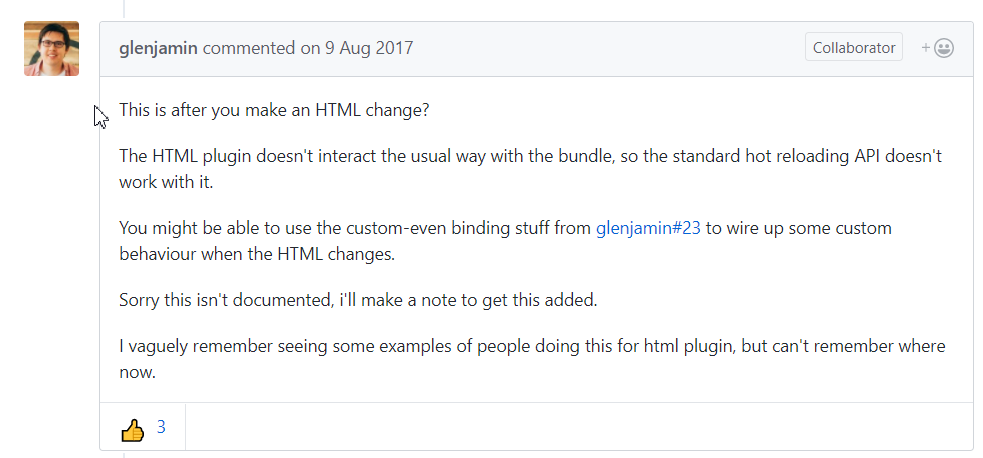在学习react的时候,经常用create-react-app来创建web应用,然而写到后面总有连自己服务器和数据库的需求,create-react-app创建的是一个webpack-dev-server,主要用来进行webpack的编译和热加载(HMR),所以想要把这两个东西融合,就是既能监听修改实现热加载,然后用的又是自己的express服务器。网上有两种解决方案:1.设置代理,同时启动express和webpack-dev-server,然后将webpack-dev-server代理到过来。2.利用webpack-hot-middleware和webpack-dev-middleware这两个插件处理编译和热加载。
在这里我选择第二种,因为觉得既然webpack-dev-server本身就是个express服务器,为什么不能把编译和HMR的功能直接用到express上呢。
但是参照https://github.com/webpack-contrib/webpack-hot-middleware/blob/master/example/server.js出现了问题。
var http = require('http'); var express = require('express'); require('console-stamp')(console, "HH:MM:ss.l"); var app = express(); app.use(require('morgan')('short')); // ************************************ // This is the real meat of the example // ************************************ (function() { // Step 1: Create & configure a webpack compiler var webpack = require('webpack'); var webpackConfig = require(process.env.WEBPACK_CONFIG ? process.env.WEBPACK_CONFIG : './webpack.config');//我这里改成了create-react-app中的webpack.config.dev(需要npm run eject看到) var compiler = webpack(webpackConfig); // Step 2: Attach the dev middleware to the compiler & the server app.use(require("webpack-dev-middleware")(compiler, { logLevel: 'warn', publicPath: webpackConfig.output.publicPath })); // Step 3: Attach the hot middleware to the compiler & the server app.use(require("webpack-hot-middleware")(compiler, { log: console.log, path: '/__webpack_hmr', heartbeat: 10 * 1000 })); })(); // Do anything you like with the rest of your express application. app.get("/", function(req, res) { res.sendFile(__dirname + '/index.html'); }); app.get("/multientry", function(req, res) { res.sendFile(__dirname + '/index-multientry.html'); }); if (require.main === module) { var server = http.createServer(app); server.listen(process.env.PORT || 1616, function() { console.log("Listening on %j", server.address()); });
简单的把config文件替换成webpack.config.dev并不奏效,发现修改js文件时,确实会重新编译但是网页不会刷新,也就是HMR失败
看了webpack-hot-middleware的issue之后找到了问题

通过作者的回答可以看出,html的插件和热加载的api是不兼容的,而create-react-app中的config中用了html-webpack-plugin这个插件,所以要用别的方法来解决这个问题。
在issue里也找到了答案,原理就是用node的chokidar模块来监听index.html的改变,然后主动发送一个reload请求给浏览器,让它刷新
demo地址:https://github.com/thesimpledesigners/webpack-hot-reload-client
首先给webpackHotMiddlewareClient添加监听事件,其中subscribe方法是注册监听事件,之后会用public方法来发布信息,就是js中的观察者模式。payload.action === 'reload'时刷新浏览器
// client.js (function() { 'use strict'; const webpackHotMiddlewareClient = require('webpack-hot-middleware/client?reload=true'); webpackHotMiddlewareClient.subscribe(function(payload) { if (payload.action === 'reload' || payload.reload === true) { window.location.reload(); } }); module.exports = webpackHotMiddlewareClient; }());
然后利用chokidar来监听index.html文件,使得其一修改就能让服务器发送一个reload请求
//./devScripts/hotReloader.js (function() { 'use strict'; const path = require('path'); const chokidar = require('chokidar'); function activate(server) { /** * Here, we use Chokidar to force page reloading for some other file types * like html changes or php if you want */ const watcher = chokidar.watch([ path.resolve(__dirname, '../index.html'),// index.html is on the root folder ]); watcher.on('ready', function() { console.log('Initial scan complete. Ready for changes'); }); watcher.on('change', function(path) { console.log('File [' + path + '] changed !'); // reload the client on file changes server.reloadClient();//这个方法要在服务器实现,就是public一个消息给hotMiddleware
}); } // here we export an activate function to activate the watcher module.exports = { activate: activate, }; }());
服务器代码:
const path = require('path');
// import express
const express = require('express');
// import webpack and the dev & hot middlewares
const webpack = require('webpack');
const webpackDevMiddleware = require('webpack-dev-middleware');
const webpackHotMiddleware = require('webpack-hot-middleware');
function createServer() {
// Step 1: create the express instance
const app = express();
// Step 2: Create & configure a webpack compiler
const webpackConf = require('../webpack.config.dev.js');
const webpackCompiller = webpack(webpackConf);
const hotMiddleware = webpackHotMiddleware(webpackCompiller);
const devMiddleWare = webpackDevMiddleware(
webpackCompiller,
{
publicPath: webpackConf.output.publicPath,
});
// Step 3: Attach the dev middleware and hot middleware to the server
app.use(devMiddleWare);
app.use(hotMiddleware);
function startServer() {
app.listen(3000, function(err) {
if (err) {
console.error(err);
return;
}
// log server running
console.log('Listening at http://localhost:3000/');
});
}// end function start server
/**
*
*/
function reloadClient() {
hotMiddleware.publish({action: 'reload'});
}// end function RelaodClient
return {
start: startServer,
reloadClient: reloadClient,
};
}
module.exports = createServer();
华丽的分割线--------------------------------------------------------------------------------------------------------------------------------------------------------------------------------------------------------------------------------------------------------------------------------------------------------------------------
总之,你如果想在express中用HMR,并且用create-react-app中webpack.config.dev的配置,只要两步:1.将服务器代码改成下方的app.js这样,2.修改webpack.config.dev中entry的配置
1:我将上面代码精炼了一下,贴一下我的服务端代码app.js
var http = require('http'); var path = require('path'); var session = require('express-session') ; var express = require('express'); const chokidar = require('chokidar'); const webpack = require('webpack'); const webpackDevMiddleware = require('webpack-dev-middleware'); const webpackHotMiddleware = require('webpack-hot-middleware'); const app = express(); app.use(require('morgan')('short')); 'use strict'; // Do this as the first thing so that any code reading it knows the right env. process.env.BABEL_ENV = 'development'; process.env.NODE_ENV = 'development'; const webpackConf = require('./config/webpack.config.dev.js'); const webpackCompiller = webpack(webpackConf); const hotMiddleware = webpackHotMiddleware(webpackCompiller); const devMiddleWare = webpackDevMiddleware( webpackCompiller, { publicPath: webpackConf.output.publicPath, }); // Step 3: Attach the dev middleware and hot middleware to the server app.use(devMiddleWare); app.use(hotMiddleware); app.active = ()=>{ const watcher = chokidar.watch([ path.resolve(__dirname, '/public/index.html'),// index.html is on the root folder ]); watcher.on('ready', function() { console.log('Initial scan complete. Ready for changes'); }); watcher.on('change', function(path) { console.log('File [' + path + '] changed !'); // reload the client on file changes hotMiddleware.publish({action: 'reload'}); }); } app.active() // Do anything you like with the rest of your express application. app.set('views', path.join(__dirname, 'views')); app.set('view engine', 'ejs'); app.use(express.static(path.join(__dirname, 'public'))); app.get("/", function(req, res) { res.sendFile(__dirname + '/public/index.html'); }); app.listen(3000, function(err) { if (err) { console.error(err); return; } // log server running console.log('Listening at http://localhost:3000/'); });
2:然后在webpack.config.dev的entry中这样修改
//require.resolve('react-dev-utils/webpackHotDevClient'), 'webpack-hot-middleware/client?path=/__webpack_hmr&timeout=20000&reload=true',
就是把原来它自己写的webpackHotDevClient注释掉,加上后面那句话。
我的demo:https://github.com/jokermask/HMRwithExpress
至此大工告成!